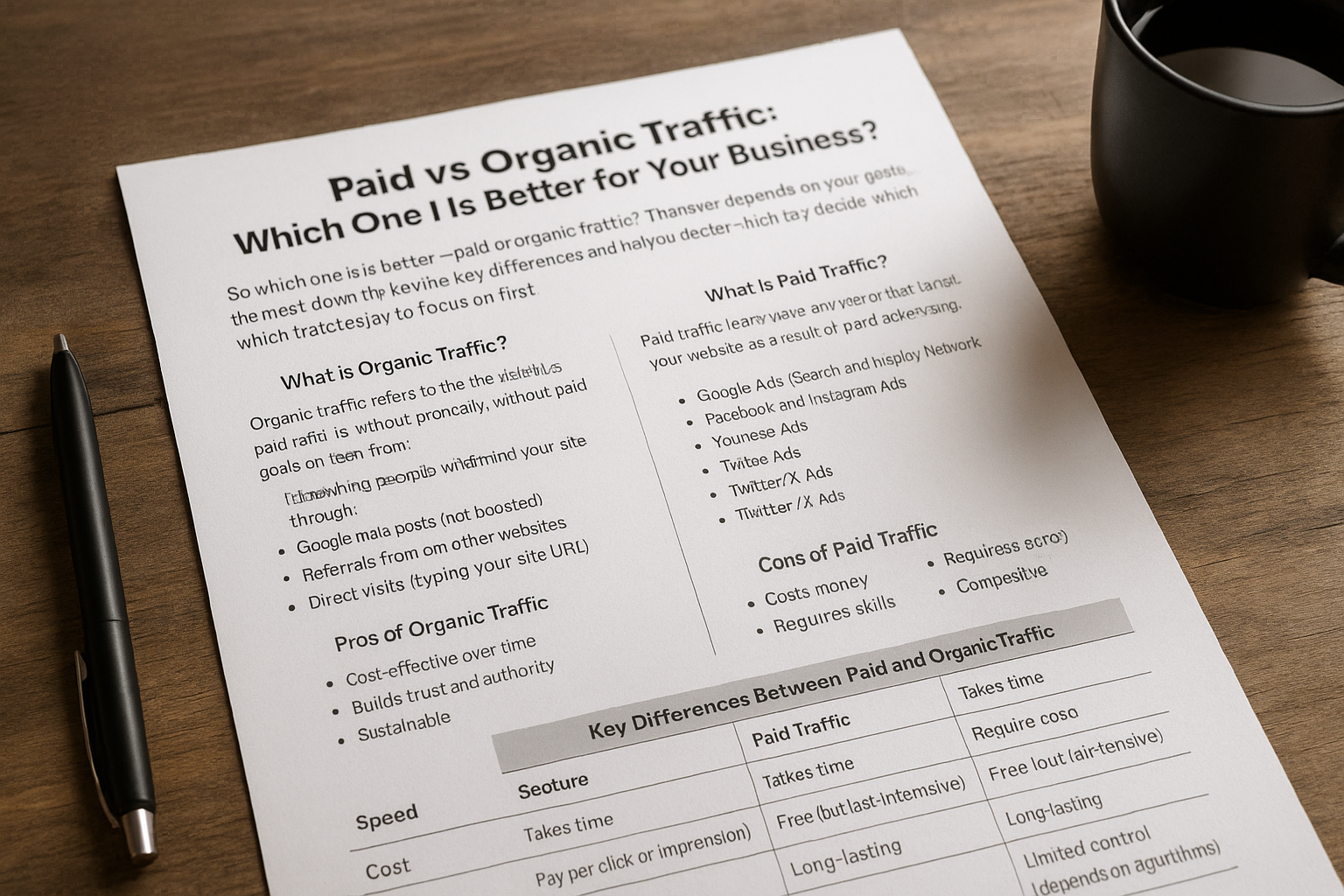If you’re just getting started in digital marketing or aiming to become a traffic manager, one of the most important distinctions to understand is the difference between paid traffic and organic traffic. These two types of traffic can significantly influence how a business grows online, each with its own advantages, challenges, and use cases.
So which one is better—paid or organic traffic? The answer depends on your goals, timeline, and resources. In this article, we’ll break down the key differences and help you decide which traffic strategy to focus on first.
What Is Organic Traffic?
Organic traffic refers to the visitors who arrive at a website naturally, without paid promotion. This includes people who find your site through:
- Google search results (unpaid listings)
- Social media posts (not boosted)
- Referrals from other websites
- Direct visits (typing your site URL)
Organic traffic usually comes from a long-term content strategy. For example, publishing blog articles optimized for SEO (search engine optimization), posting regularly on social media, or building a strong backlink profile.
Pros of Organic Traffic
- Cost-effective over time: Once content ranks or goes viral, it brings traffic without further investment.
- Builds trust and authority: Users tend to trust organic search results more than ads.
- Sustainable: Well-optimized content can continue to bring traffic for months or years.
Cons of Organic Traffic
- Takes time: It can take 3–6 months or more to see results from SEO.
- Requires consistent effort: You need to keep publishing and optimizing.
- Less control: Algorithms determine visibility, and changes can impact your traffic suddenly.
What Is Paid Traffic?
Paid traffic is any visitor that lands on your website as a result of paid advertising. This includes:
- Google Ads (Search and Display Network)
- Facebook and Instagram Ads
- YouTube Ads
- TikTok Ads
- Twitter/X Ads
- Native ads on websites
You choose a platform, set a budget, and your ads appear to targeted audiences—instantly driving traffic to your site.
Pros of Paid Traffic
- Immediate results: You can start getting clicks and conversions the same day.
- Highly targeted: You can control who sees your ads based on location, interests, behavior, and more.
- Scalable: Increase your budget and reach a larger audience quickly.
Cons of Paid Traffic
- Costs money: When the budget stops, so does the traffic.
- Requires skills: You need to know how to manage campaigns properly.
- Competitive: Popular niches can have high cost-per-click (CPC).
Key Differences Between Paid and Organic Traffic
| Feature | Paid Traffic | Organic Traffic |
|---|---|---|
| Speed | Instant results | Takes time |
| Cost | Pay per click or impression | Free (but labor-intensive) |
| Sustainability | Stops when ads stop | Long-lasting |
| Control | Full control over targeting and budget | Limited control (depends on algorithms) |
| Trust | Lower (people know it’s an ad) | Higher (seen as more genuine) |
| Learning Curve | High (technical and strategic) | Medium to high (SEO and content skills) |
When to Use Paid Traffic
Paid traffic is best when you:
- Are launching a new product or service
- Want to test offers quickly
- Need fast results for a campaign
- Have a solid landing page and sales funnel ready
- Have a budget for experimentation
Many businesses use paid traffic to validate ideas or to scale once their funnel is proven.
When to Focus on Organic Traffic
Organic traffic is ideal when you:
- Want to build a long-term content strategy
- Are growing a blog, YouTube channel, or social media presence
- Don’t have a large advertising budget
- Are trying to build brand authority and visibility
- Have time to invest in SEO and content
It’s also an excellent foundation—many businesses combine SEO and social media to generate traffic without ongoing ad costs.
Should You Combine Both?
Yes, and this is often the best strategy.
For example:
- Use paid traffic to drive short-term results while you build your organic presence.
- Promote high-performing organic content using ads to reach more people.
- Retarget website visitors using paid remarketing ads to increase conversions.
- Use SEO to dominate long-term while testing new offers through paid ads.
By combining the two, you get the best of both worlds—fast results and lasting growth.
Budgeting for Both Types
If you’re managing traffic for clients or your own business, here’s a simple way to balance budgets:
- Allocate 60–70% for paid traffic if fast growth is needed.
- Invest 30–40% in organic content to build sustainable traffic sources.
As your organic traffic grows, you may reduce ad spending or shift budget to retargeting and scaling proven campaigns.
Learning Both Skills as a Traffic Manager
A professional traffic manager should understand both paid and organic traffic—even if they specialize in one. Why?
- Clients may ask for SEO recommendations or content advice.
- Paid traffic often works better when paired with SEO-optimized landing pages.
- Organic traffic can support client growth when ad budgets are limited.
Courses, YouTube channels, and communities focused on SEO, copywriting, and content marketing are great places to start learning about organic traffic. For paid traffic, focus on Meta Blueprint, Google Skillshop, and real campaign practice.
Final Verdict: It’s Not Either/Or — It’s When and How
The better question isn’t “which one is better,” but when to use each.
If you need quick results, go with paid traffic. If you want to build something sustainable and trustworthy, invest in organic strategies. Ideally, use both to maximize your growth potential.
Smart traffic managers and business owners know that in the digital world, visibility is everything—and a balanced strategy keeps the traffic flowing no matter what changes come next.

